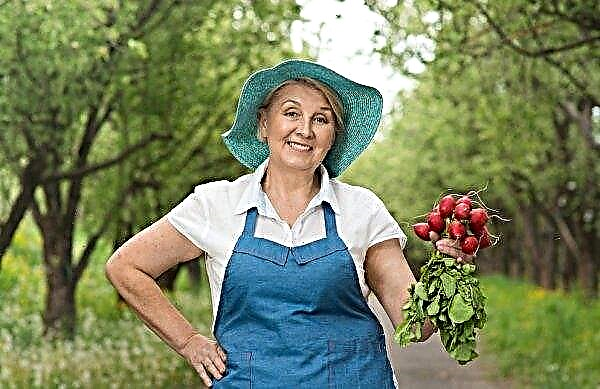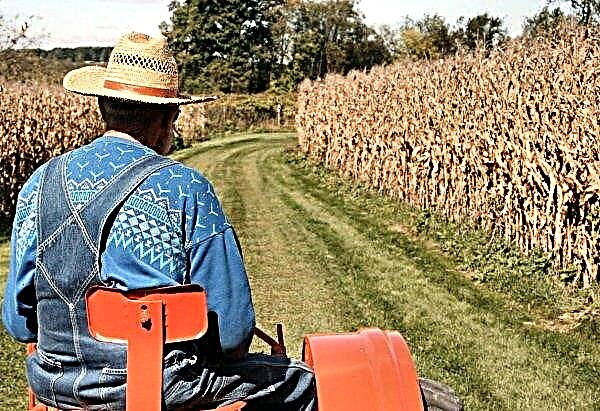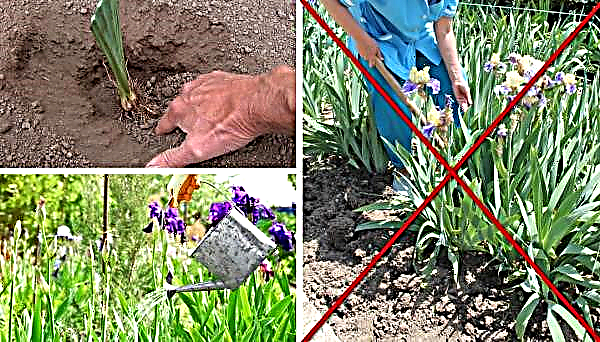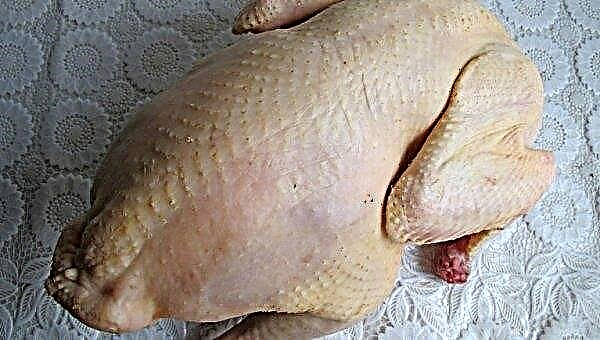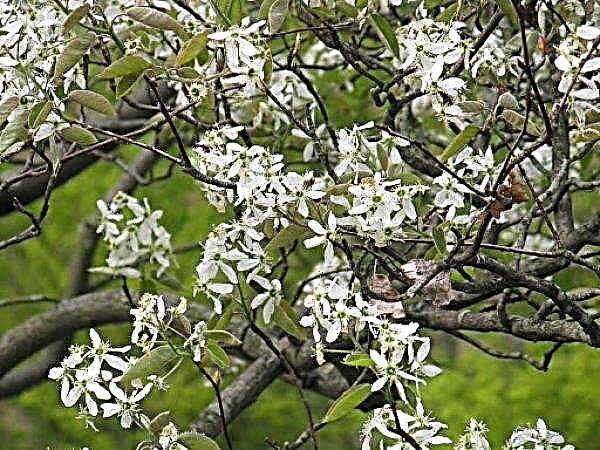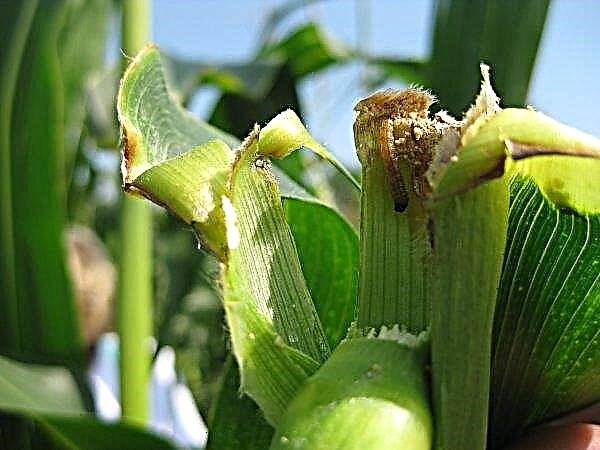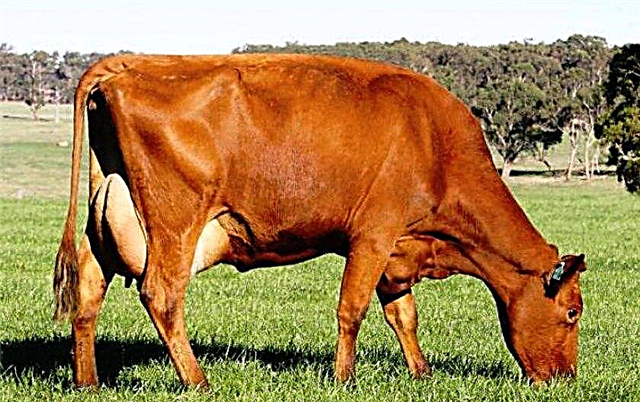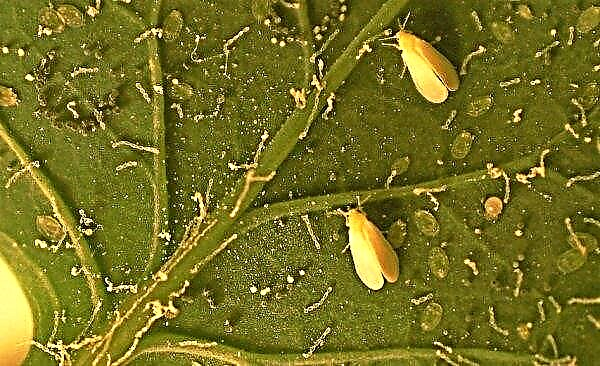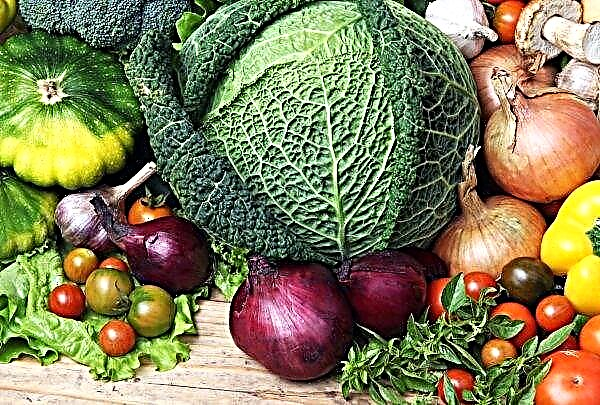Tomato "Katya f1", according to reviews of vegetable growers, is one of the best in the early ripening group. From this article you will learn all about the features of growing, quality characteristics of the variety and methods of care for it.
Grade description
"Katya f1" is a hybrid created by Russian breeders in the early 2000s. “F1” means that it is a hybrid of the 1st generation (that is, for its selection, the highest quality material of several genetically different varieties was used, from which the best traits were inherited).
Did you know? “Kati” seeds, like other hybrids, do not retain varietal traits, so collecting and sowing them for the next year is pointless. To get a quality crop, you need to buy a new planting material every time.
It is worthwhile to dwell in more detail on the characteristics and external description of the hybrid:
- it is a low (up to 60 cm) determinant plant with medium-dense foliage;
- inflorescences are formed over the 5th leaf, in each brush 7-9 fruits are tied;
- by maturity, the variety is ultra-ripe (the vegetative period from seedlings to harvest is 75-80 days);
- the fruits are rather large (120-130 g), roundish, slightly flattened, uniform bright red color, without a green spot under the stalk;
- the taste of tomatoes is saturated, slightly sweet; the pulp is juicy, fleshy, with a solids content of 4.6%;
- fruits ripen en masse and almost simultaneously;
- yields are estimated as high (from 1 m² of bed you can collect 8-10 kg of tomatoes, and in greenhouse conditions - up to 15 kg);
- the purpose of tomatoes is universal: they are suitable for preservation, preparation of juices and consumption in kind;
- bushes are resistant to weather factors - they are not afraid of drought, rain, temperature changes;
- plants are not demanding on care and agricultural technology;
- not susceptible to the main diseases of tomatoes: tobacco mosaic, late blight, vertebral rot.

Advantages and disadvantages
- Assessing the positive qualities of the variety, one of the first can be noted:
- early and simultaneous ripening of fruits;
- good resistance to most diseases and negative weather factors;
- rich taste and quality of tomato pulp;
- excellent presentation and good preservation of the crop;
- the possibility of long transportation;
- resistance of tomatoes to cracking;
- high productivity;
- universal use of fruits.
- The disadvantages of the hybrid are still there:
- the possibility of defeating bushes with fomosis;
- fragility and tendency of branches to break;
- congestion in the crop.
Self-growing seedlings
Hybrid "Katya" was bred taking into account the climatic conditions of the North Caucasus, so it can not be sown immediately in open ground (especially in cold regions). Breeders recommend growing this tomato through seedlings, given some requirements.
Important! If you want to get the maximum yield from this variety, grow seedlings only in separate containers. So it will turn out stronger. And the stronger the seedlings, the higher the yield.
Sowing dates
When calculating the timing of sowing, it should be borne in mind that Katya is an early ripening tomato ripening approximately 80 days after emergence. To this period, you need to add 7-10 days for seedlings and another 5-7 days for adaptation after transplantation into open ground. Therefore, sowing seeds in late March - early April, the crop can be harvested in the second half of June. In greenhouses, fruit ripening occurs a couple of weeks faster.
The soil
To grow seedlings requires a light nutrient substrate. It can be purchased in a store or made independently from equal parts of peat and sand. Since peat always has a high acidity, it is useful to add some wood ash to the substrate, which neutralizes this acidity. Self-prepared mixture must be decontaminated - warm at a temperature of 60-70 ° C, pour cool boiling water or a solution of potassium permanganate.
Capacity for growing
Some summer residents prefer to sow seeds in a large container, and then dive sprouts in separate cups. In this case, this method is not the most suitable, since the Kati seedlings are quite voluminous - it has wide leaves, which begin to interfere with each other as they grow. Therefore, it is better to immediately select small individual containers for each plant.
It can be disposable cups or pre-made cassettes sold in any garden store. Capacities must have openings to remove excess moisture. It is convenient to use peat tablets for sowing seeds. They already contain the necessary nutrients and growth stimulants, so seedlings are developing splendidly in them.
Did you know? The roots of tomatoes are very developed and deep - they can grow up to 1.5-2 m wide and deepen up to 1 m. And the higher the stem, the longer the roots.
Seed preparation
Before planting, the seeds are recommended to be disinfected and kept in a humid environment to soften the shell. For disinfection, you can use a 1% solution of potassium permanganate or 3% hydrogen peroxide. The seed is soaked for half an hour, at the same time rejecting inferior seeds that have surfaced. Next, the seeds are washed with water and laid out on a damp cloth dipped in a growth stimulator. As a stimulant, you can use ready-made drugs ("Heteroauxin", "Pennant", "Zircon"), or natural liquids (aloe juice, melt water). Preparing melt water is easy. It is necessary to fill the bag with water, put it in the freezer, and when the water freezes to half, drain the liquid and thaw the ice formed. It will turn out very clean, biologically active water, in which the seeds will germinate in 2-3 days. To accelerate seedlings, the material can be warmed before soaking.
As a stimulant, you can use ready-made drugs ("Heteroauxin", "Pennant", "Zircon"), or natural liquids (aloe juice, melt water). Preparing melt water is easy. It is necessary to fill the bag with water, put it in the freezer, and when the water freezes to half, drain the liquid and thaw the ice formed. It will turn out very clean, biologically active water, in which the seeds will germinate in 2-3 days. To accelerate seedlings, the material can be warmed before soaking.
Sowing seeds
Germinated seeds are planted in a moist substrate to a depth of 1.5 cm. Planting is best done with nests of 2 seeds in case not all sprout. When planting in a common container, the distance between the nests should be 3-4 cm. After sowing, the soil should be leveled, sprayed from the spray bottle, cover the container with glass or polyethylene and put in a bright warm place. Before seedlings should be maintained at a temperature of + 22 ° C- + 23 ° C.
Important! It is necessary to remove ripened fruits on time, as they create an additional load on the plants.
Seedling Care
With the advent of the first shoots, the shelter is removed, and the surrounding temperature is lowered to + 16 ° C- + 18 ° C. This is necessary so that the plants do not stretch. After a week, when all the seedlings appear, the degree is again increased to + 20 ° C- + 23 ° C, but not higher, since in the heat the plants grow and stretch too quickly. Basic care for growing tomatoes consists of moderate irrigation with settled water and 1-2 fertilizing with complex fertilizers. If a special substrate for seedlings or peat tablets were used, then top dressing is not needed at all. Daylight hours for seedlings should be at least 12 hours, so on cloudy days you will need additional lighting. If seedlings are grown in a common container, then when 2 true leaves appear, they will be dived into separate pots.
If a special substrate for seedlings or peat tablets were used, then top dressing is not needed at all. Daylight hours for seedlings should be at least 12 hours, so on cloudy days you will need additional lighting. If seedlings are grown in a common container, then when 2 true leaves appear, they will be dived into separate pots.
Seedling hardening
A couple of weeks before planting on the garden bed, plants need to be hardened, that is, accustomed to the influence of environmental factors: wind, sun, temperature changes. To do this, the tanks are taken out onto the street for several minutes daily, gradually increasing the time to several hours.
Important! It is better to harden seedlings in the morning, as the daytime sun can cause burns to delicate leaves.
Planting seedlings in a permanent place
Seedlings are planted on the bed at the age of about 1 month, when its height reaches 15-20 cm. It is recommended to planting no earlier than the threat of night frost passes, and the soil warms up to + 15 ° C. Typically, this weather is set in late May - early June. This is due to the fact that tomatoes are heat-loving plants, and at a temperature below + 13 ° C their growth stops. Therefore, in cold regions, it is better to plant culture immediately in greenhouses and not risk it. The bed needs to be prepared in advance: dig, break up clods of earth and level. Planting seedlings is carried out in holes at a distance of 50-60 cm between the seedlings. If the soil is not fertile enough, fertilizers can be applied directly to the hole (1 handful of compost or 1 tsp superphosphate). Seedlings of this variety are recommended to be deepened to half the stem, which will make it possible to form a stronger root system.
The bed needs to be prepared in advance: dig, break up clods of earth and level. Planting seedlings is carried out in holes at a distance of 50-60 cm between the seedlings. If the soil is not fertile enough, fertilizers can be applied directly to the hole (1 handful of compost or 1 tsp superphosphate). Seedlings of this variety are recommended to be deepened to half the stem, which will make it possible to form a stronger root system.
Features of outdoor care
After landing on the garden, tomato care consists of other activities.
Watering
The bushes are watered with cold, standing water only under the root, since fungal diseases can develop when moisture gets on the leaves. In hot weather, watering should be regular and plentiful (at the rate of 0.8-1 l of water per bush). Watering is better in the afternoon. At the beginning of flowering and pouring fruit, watering should be more intense.
Top dressing
For the entire growing season, tomatoes are fed no more than 2 times (for early varieties this is quite enough). The first feeding is done 10-14 days after planting on the bed using a mixture of mineral and organic fertilizers (mullein diluted with water in a proportion of 1:10 plus 20 g of superphosphate). The amount is designed to feed 10 plants. The second top dressing consists of mineral fertilizers diluted in water and introduced under the root. For 1 m² of bed, 15 g of potassium salts, 20 g of superphosphate and 10 g of saltpeter per 10 l of water are required. This top dressing should be carried out no later than a month before the harvest, otherwise the fruit will contain harmful chemical impurities.
The second top dressing consists of mineral fertilizers diluted in water and introduced under the root. For 1 m² of bed, 15 g of potassium salts, 20 g of superphosphate and 10 g of saltpeter per 10 l of water are required. This top dressing should be carried out no later than a month before the harvest, otherwise the fruit will contain harmful chemical impurities.
Stepson
Removing stepchildren for this variety is not necessary, but desirable. Like any determinant tomato, Katya ceases to grow, reaching a height of 50-60 cm, but lateral shoots (stepsons) still consume bush nutrients in the axils of the leaves. Their timely removal will allow us to direct all this stock to the ripening of fruits. It is recommended to form a bush in 2 or 3 stems, leaving the main shoot and 1-2 of the strongest additionally. Pasynkovka is best done in the morning so that the slices can dry out during the day.
Soil care
For good tomato growth, it is necessary to keep the bed clean, to loosen in time and maintain optimal humidity. Regular weeding is extremely important for bushes, because weeds are carriers of fungi and pest larvae. It is also necessary periodically (2-3 times) to deeply loosen the soil and spud the bushes. To reduce the need for watering and harvesting weeds, the bed can be mulched with straw, dry compost. These materials will not only protect the soil, but also serve as additional fertilizing for the tomato.
Tying bushes
As already noted, the Katya tomato bushes are low (and at the same time very productive), therefore, tying the stems for them is necessary. If this is not done, the bush will fall to the ground, which will lead to damage to most of the crop.
You can tie plants in several ways:
- to a peg driven into the ground near the bush - the main stem is tied with a rope near the crown;
- using a trellis - several stakes are driven in at a distance of 40-45 cm; a wire is stretched between them in rows, to which the shoots are attached;
- with the help of a linear design - stakes are dug around the edges of the tomato row, a cable is pulled between them, ropes are attached to it, one end of which is tied to the central shoot;
- In the same way, you can fix the bushes with hooks - at the end of each rope, a hook is attached that holds the stems of the tomato.
Preventative treatment
The variety is resistant to specific diseases of tomatoes, but sometimes damage to bushes is possible. phomosis. To prevent the development of this disease, it is recommended to spray plants before flowering the drug "Hom", Bordeaux liquid or other copper-containing fungicide. Processing will serve as a good prevention of any fungal diseases that occur against a background of high humidity.
From the invasion of harmful insects like aphids, colorado beetles, spider mites any complex biological product will protect plants ("Verticillin", "Actofit"). It is more reliable to deal with pests that live in the soil (May beetle, bear, nematodes) by mechanical methods, among which deep loosening of the soil and manual removal of insect larvae are distinguished. Tomato "Katya f1" for many years holds a leading position in the line of early ripening varieties. Gardeners fell in love with it for friendly ripening, resistance to negative factors, good taste and excellent presentation of fruits that can be grown not only for themselves, but also for the purpose of realization. The hybrid is convenient in that it is not picky about maintenance, therefore it gives a good harvest in any soil and different climatic conditions.
Tomato "Katya f1" for many years holds a leading position in the line of early ripening varieties. Gardeners fell in love with it for friendly ripening, resistance to negative factors, good taste and excellent presentation of fruits that can be grown not only for themselves, but also for the purpose of realization. The hybrid is convenient in that it is not picky about maintenance, therefore it gives a good harvest in any soil and different climatic conditions.

